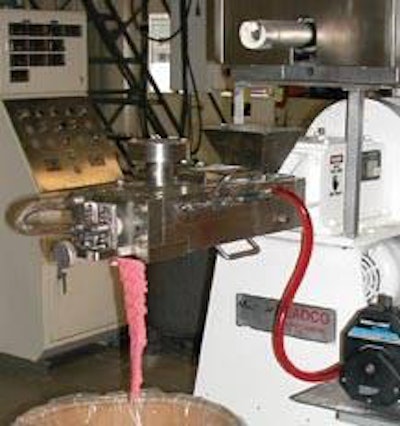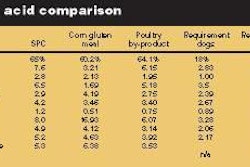
The mixing field continues to evolve. Industries from food to automobiles have benefited from advances in mixing technology. The petfood industry is no exception. It too searches for ways to cut costs and increase efficiency while paying attention to the intricacies that separate petfood manufacturing from other manufacturing processes.
Mixing 101
Mixing is the process where two or more ingredients are blended together until the substance is uniform in consistency. Shear is the process of one material separating into small particles and dispersing throughout another. Shearing requires the input of energy to separate and mix the components. Because the shearing times for particles within a mixture are not the same, their temperatures become inconsistent. Therefore, particles that were sheared early in the mixing cycle have higher temperatures than those sheared at the end of the cycle. The longer a product is mixed, the more pronounced its shear/heat history will be. An extreme shear/heat history can be detrimental to heat-sensitive ingredients, but is appropriate if your product required a long reaction time.
Seven challenges
Any mixing discussion in the petfood industry centers around seven basic challenges:
- Combining ingredients with fillers that provide flavor and nutritional value;
- Feeding irregularly-shaped products (meats, vegetable bits, rice, corn and soy products);
- Uniformly coating or "wetting" all the filler material for proper consistency;
- Preserving the physical properties of filler materials;
- Producing a consistent product;
- Providing ease of handling; and
- Generating economies of floor space, production labor and simplicity.
The two most common ways of meeting these challenges are batch mixing or continuous mixing.
Batch mixing
Batch mixing is similar to the concept of baking cookies at home. You prepare a predetermined amount of mixture in a container, use it for your batch of cookies, clean the container and then prepare another batch if you want more cookies.
Batch mixing is the traditional mindset when evaluating mixing processes and can be advantageous for some industries. It can be applied to many different production rates. It is easy to install and implement. The process is often sufficient for small production quantities.
There are three areas of concern that can arise from the longer production process associated with batch mixing:
- A pronounced shear/heat history can be a detriment to heat-sensitive products;
- Treating large volumes of product within a reasonable time is sometimes difficult, as it takes a long time to turn over the entire volume; and
- Longer mix cycles often degrade the size and shape of the filler materials, forcing companies to either trash the batch or remove the damaged filler materials and replace them.
Other batch mixing challenges include batch-to-batch variations and extensive cleanup when changing to a different product color or type. These can translate into higher labor and handling costs.
Continuous mixing
Continuous mixing is not as widely known as batch mixing. The continuous process consists of a mixer being fed by dry powder feeders and by liquids from appropriate pumps. The formulation of the ingredients has been predetermined, and the pumps and feeders are set to dispense the required amounts of each. Continuous mixers are appropriate for products with viscosities from 20,000 centipoises to 50 million centipoises.
Three basic steps are accomplished within the mixer and complete the mini-production process:
- Blending/homogenization : blending occurs so quickly that the mixture is homogenized in seconds.
- Shearing with temperature controlonce: the product is homogenized, the shear/heat history is short and uniform. The mixture passes through a set of paddles for shearing. The configuration of the adjustable paddles is specifically designed to obtain the final product's unique characteristics. As materials pass through the paddles, its temperature is regulated by multiple temperature controls located on the outside surface of the mixer. The rapid heating and cooling significantly reduce processing time.
- Extruding/grinding : this final step in the continuous mixing process provides the product's final output. Once the product's desired physical attributes are obtained, it can be formed into bars, rods, strands, pellets, or it can be ground. A contoured extrusion die plate at the discharge end of the mixer can be customized to produce any size or shape.
Calibration and monitoring of metering equipment are essential for a consistent product. Where possible, ingredients are combined to reduce the number of desired feeders and pumps in the continuous process. If additional ingredients are needed, other entry points are available by adding new feed lines.
Once the equipment selection, mixing time and intensity and the sequence of ingredient additions are established, the process can run nearly unattended, but not unmonitored.
One of the major problems facing petfood manufacturers is the uniform and consistent feeding of irregularly-shaped products, such as meats, vegetable bits, rice, corn and soy products. This challenge can be solved in continuous processing by determining the correct combination of feeders that will achieve a consistent product.
Continuous mixing may not be a good fit if your product requires long periods of stagnation to achieve its desired composition. Also, product changes may require significant cleaning of lines, mixers and feeder pumps.
Selecting a mixing process is both mechanical and psychological. The other major challenge for a company to adopt continuous mixing is changing their mindset and overcoming the skepticism of doing things differently.
Testing your mixer choices
In many product development or improvement scenarios, mixing is an afterthought. However, it is important for manufacturers to consider the effects a mixer can have on their product formula. Mixer testing is essential to determine the feasibility of production, and to uncover the distinctive aspects of the product's properties. Tests may be completed in one or two days, and a mixer supplier can assist by providing facilities and equipment.
Videotaping is often used to document the test, but it is no substitute for the manufacturers' involvement. By participating in the tests, manufacturers will gain product knowledge and a better understanding of the mixing variables as they apply to their product. Also, since the test is a mini-production line, the manufacturer will get a better understanding of the entire process.
The bottom line
Manufacturing processes are not simple anymore. New methods must be found to keep up with a changing world. Manufacturers can, and should, find the right combination of mixers and mixing processes that will satisfy the exacting requirements of their products.
Petfood manufacturers need to cost-efficiently produce a consistent product in large volumes. Batch mixing may or may not offer the consistency or the volume needed for most firms, but it has other advantages. Continuous mixing historically provides a uniform product while cutting costs and creating a more efficient manufacturing environment.

















